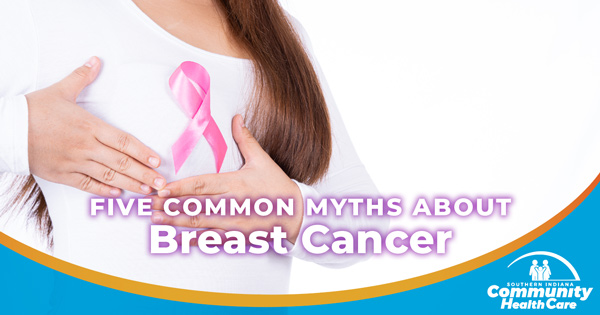Five Common Myths about Breast Cancer

By Curtis Thill, M.D.
The two words “breast cancer” can unfortunately strike fear into the hearts of some women. It is true that breast cancer is the most common cancer found in women, but it’s also true that you can do many things to lower breast cancer risks. The more you know, the better you can work to lower risks and have peace of mind (you may find this online toll to be useful to help assess personal risk elements: https://bcrisktool.cancer.gov/
Here are some common myths we sometimes hear in our southern Indiana practice:
Myth No. 1 – Detecting a lump in your breast means you probably have cancer.
This is not true. While self-examination and checking your breasts for unusual lumps or changes (including sensitive or painful areas) is a good first line of defense, you should know that only a small number of lumps actually turn out to be cancerous. If you feel an unusual lump, it’s time to bring that to your medical provider’s attention. A lump or swelling can arise for different reasons and are often benign (non-cancerous). A medical examination and possible tests will provide good answers.
Myth No. 2 – No lumps means no cancer.
This is not necessarily true. While the absence of unusual lumps or changes often is a good sign, cancer may be aggressively developing unseen. Regular checkups help detect early – and treatable – issues. For women over age 50, regardless of whether unusual changes present themselves, an annual mammogram should be high on the list. A monthly self-exam represents a good habit of self-care (and by the way, mammograms do not cause breast cancer).
Myth No. 3 – Only women over 50 get breast cancer.
This persistent myth can be deadly. The fact is that nearly 10 percent of breast cancer diagnoses occur in women under the age of 45. Of these incidences in younger women, the cancer often presents at a later stage. If you have a close relative who was diagnosed with breast or ovarian cancer, you might face a higher risk. Being aware represents a good defense.
Myth No. 4 – Breast cancer is more common in women with bigger breasts.
The good news? No connection exists between breast size and cancer risk. However, it should be noted that being overweight (obesity), the density of breast tissue and other behavioral factors like smoking can heighten risks of developing breast cancer.
Myth No. 5 –Pain in your breast means you have breast cancer.
The fact? Breast pain by itself is not typically a symptom of breast cancer. Some professionals estimate that only a small number of breast diagnoses arise from reports of breast pain. Pain can come from a variety of different sources. While the most common symptom of breast cancer appears as a lump, other symptoms possibly include unusual swelling, changes in a nipple or breast skin, swollen lymph nodes (often in the armpit area), or unusual pain in the breast or nipple. Again, your medical provider can help analyze and identify unusual signs, especially important if you’re over age 50.
Other potential risk indicators you should be aware of include a family history of breast cancer (gene testing is an option for a woman if close relatives had breast cancer), menstruation onset before age 11, and not having a child before the age of 30.
What can be done to lower risks? Being aware of early signs represents a key step, but you should also work to eat a variety of vegetables, fruits, whole grains, and beans. If you have small infants (or are planning a family), consider breast-feeding, as it can lower later risks.
Cut back on fats and foods with high cholesterol. Regular exercise, even three 30-minute brisk walks a week, can elevate health and reduce risks. Stopping smoking and moderating alcohol intake also rank high. You will also benefit from finding and partnering with a good medical provider who will walk alongside you on your health journey. Minimize and eliminate worry by debunking myths and taking preventative action!
A board-certified family physician, Dr. Curtis Thill has practiced medicine in southern Indiana for more than three decades.
